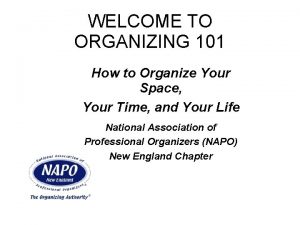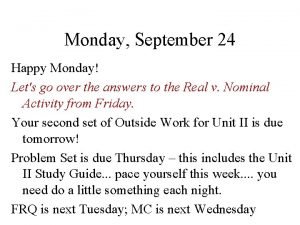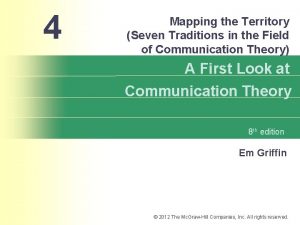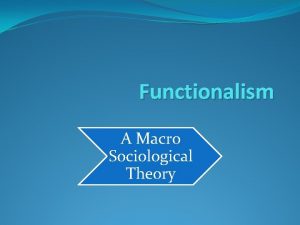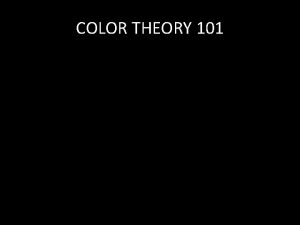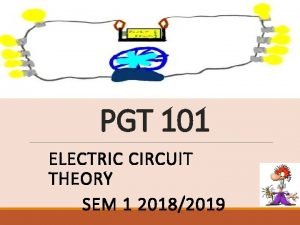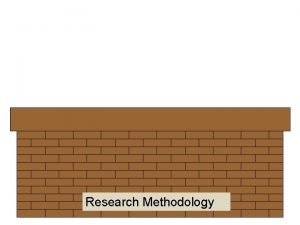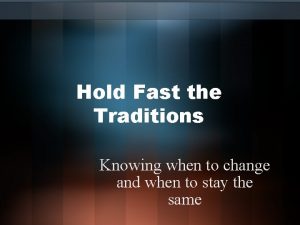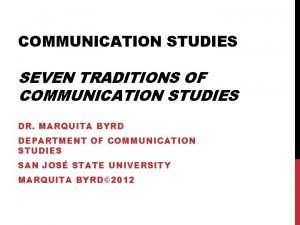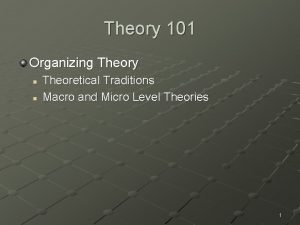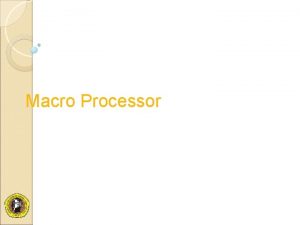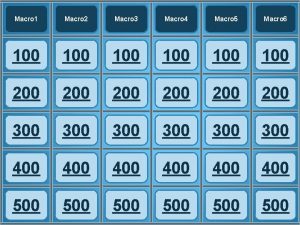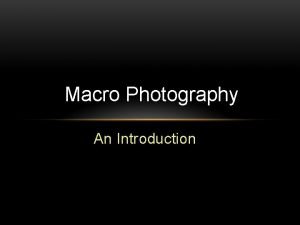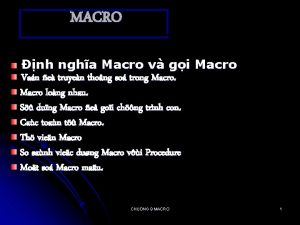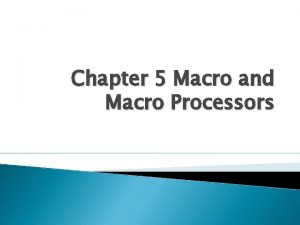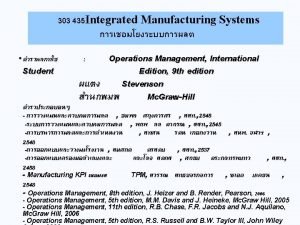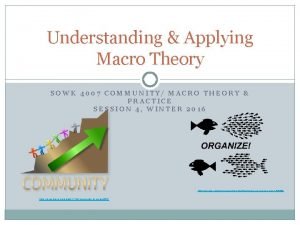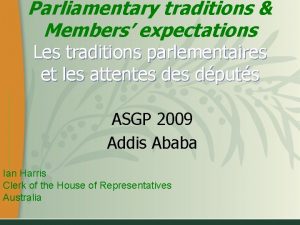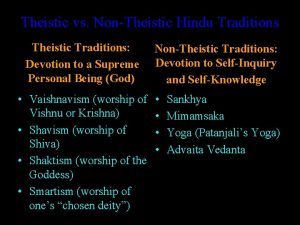1 Theory 101 Organizing Theory Theoretical Traditions Macro





























- Slides: 29

1 Theory 101 Organizing Theory Theoretical Traditions Macro and Micro Level Theories

Neoclassical Criminology The Classical School + Rebirth Deterrence Theory Rational Choice Theory 2

3 Before the Classical School of Criminology Prior to the 1700 s “The devil made me do it” It was god’s will Justice system? Torture to confess, new laws created by judges after the fact Punishments/ Crime severity not equal to punishment severity Painful corporal and capital punishments

4 The Classical School of Criminology The Age of Enlightenment (1750 -1850) Beccaria, Bentham & others: Need for A Rational Punishment System Hedonistic God Calculus grants individuals “free will” Possible SWIFT to control behavior through formal punishment AND CERTAIN A BIT MORE SEVERE THAN GAIN FROM CRIME

The Classical School Fades By the early 1900 s, most dismissed this as a valid theory of criminal behavior Changes in legal system didn’t lower crime rates “Armchair theorizing” questioned Humans as “determined” rather than “rational” From early 1900 s until the 1970 s, the positive school was unchallenged Sociology cause) was dominant force (search for root

6 REBIRTH in the 70’s and 80”s Social Context of late early 1970 s Martinson Report and the “nothing works” attack on rehabilitation Quote about deterrence theory Thinking About Crime by James Q. Wilson attacks view that crime is a function of external forces Wilson proposes a forceful reaction to crime, otherwise, those sitting on the fence will get the idea that “crime pays” Policy analysis (political scientist) = what are the realistic policy choices of a government?

7 Neoclassical Language All of these are justifications for punishment Deterrence Theory Incapacitation Just Deserts / Retribution Only deterrence is a theory of crime

8 Deterrence Theory ASSUMPTIONS Hedonistic Calculus Humans are rational, thoughtful, critters, and consider the consequences of our actions Fear of formal punishment is the key restraint for crime Banking on police and prisons as primary concern of a potential criminal

9 Types of Deterrence General Who Can vs. Specific Deterrence is being deterred? operate at macro level or micro level Macro = compare cities, states, countries Micro = individuals Absolute Almost vs. Marginal effects all tests are of marginal increases in punishment

10 General Deterrence Research Objective Severity Death Measures of Severity penalty, sentence length, time served Certainty Clearance rate/arrest rate research Possible “tipping effect” found in studies of FL and PN Modest crime decline with clearance rate >30 -40%

11 Manipulation of Certainty The Kansas Preventative Patrol Experiment Samuel Walker’s “mayonnaise” theory of police patrolling. But, “directed patrols” and “saturation patrols” may be effective Houston Preventative Patrol Experiment Ann Maahs theory of mayonnaise

12 Saturation Patrols / Other Crackdowns Upside With sufficient numbers, they can suppress serious crime Downsides? Crime displacement and/or rebound Citizen-police relationships Long term effects on residents

13 Focused Deterrence David Kennedy Deterrence and Crime Prevention Operation Ceasefire (Boston) Cincinnati Initiative to Reduce Violence Program Features Notification (call-in, tell offenders) Threat + Follow Through Pulling levers (Al Capone style) KENNEDY INTERVIEW

14 Focused Deterrence II Upside Unlike saturation patrols or other “zero tolerance” policing, this is more of a surgical strike Build community support (instead of anger) Downside Appears to be hard to maintain Keep competing agencies working together, keep threat “real” Evidence of effectiveness isn’t real firm

15 Perceptual Measures of General Deterrence Ask people on surveys: What are the odds that you would get apprehended if you did _____ How severely would you be punished if you did _____ Those who think the odds of apprehension are high and the penalties are severe should be less criminal HOWEVER: Largely an “EXPERIENTIAL” Effect (criminal experience perceptions) Think Prescription Stimulants or Other Drugs

16 Manipulating Perceptions of Severity—Scared Straight! Juvenile Awareness Project Help (JAPH) Rahway Prison, NJ (created in 1976) The Program Intimidate kids (delinquents? ) and show them how bad prisons are Tour of prison, “rap session” with “lifers”… Scared Straight! Documentary Claimed success rate of 94%, won Academy Award, immensely popular with public Redone by MTV in 1999. Claimed 12/14 (86%) were “scared straight” Redone in 2011 on A&E as “Beyond Scared Straight”

17 Things to watch tomorrow Effort made by inmates to convince the kids that Sanctions (prison) are very painful There is a high certainty that the kids will end up in prison if they don’t stop committing crime We’ll look at the evidence after the film

18 SPECIFIC DETERRENCE Individuals who are caught and sanctioned by the criminal justice system will be less likely to re-offend Does prison reduce recidivism? Do “deterrence based” programs reduce recidivism? BOOT CAMPS INTENSIVE PROBATION

19 Boot Camps Nature of Boot Camp (BC) Relation to Deterrence Theory Other vague theories tied into (BC) Evidence Over 35 experiments of reasonable quality conducted Most find no difference, the few that find differences go both ways Some evidence that BC with strong rehab component and good “aftercare” reduces crime

20 Intensive Supervision Probation The nature of ISP Make Tie probation meaner to deterrence Pain + Reduced opportunity to offend RAND 10 experiment sites across country with random assignment No difference in arrest for new crimes ISP groups much more likely to get technical violations

21 Minneapolis domestic violence study (Larry Sherman) Randomly officers assign d. v. strategies to police Arrest, Counsel, or Separate for 8 hours Arrest as painful “deterrent” Findings: Arrest = 10% re-arrested after 3 months Counseling = 19% Separate = 24% BUT: Replications not supportive May work better with people who are tied to community

22 What about JOE?

23 Joe’s Study University of Arizona Money from Joe to see whether his jails reduced crime Comparison of cohorts of inmates pre-Joe and during-Joe There was no difference in recidivism rates

24 Conclusions Regarding Empirical Support Weak empirical support If anything, the certainty of punishment may have marginal effects on crime Clearance WHY rate, focused deterrence, etc. SO WEAK? Based on “weak” theory—weak assumptions Limits of deterrence in a democratic society MARGINAL vs. ABSOLUTE

25 Policy Implications of Deterrence Policy Implication = If theory is correct, what can be done to reduce crime? Rehabilitation, (unless painful) won’t work, and may “send the wrong message” Raising the certainty, swiftness or severity of criminal penalties will work If system cannot be swift, severe and certain enough, then reduce opportunities for offending Incapacitation

26 Incapacitation A thug in prison can’t shoot your sister Easy (thought expensive) to do—we have the technology Common sense/logic dictates that some crime reduction will be achieved

27 Incapacitation II How well does it work? Comparing states to each other Projecting crime savings from surveys of people entering jails Examining states that are forced to release inmates Works best for high rate offenses (burglary, robbery, theft)—not at all for homicide Doubling prison population from 400 K to 800 K reduced robbery by 18%

28 Incapacitation III Downsides Least effective for crimes that most scare Americans (rape, homicide) EXPENSIVE Marginal effects—the more you do it the less it works. Fighting the “age crime curve” May be counter productive over long term (nothing positive happening in prison)

29 What About Informal Sanctions? Fear of Informal Sanctions is not “Deterrence theory. ” Informal social control theory (Hirschi, others) However, formal sanctions may “kick in” informal sanctions. Arrest may disappoint parents Prison may alienate family/friends
 Organizing 101
Organizing 101 Happy
Happy Keyword macro parameters in system software
Keyword macro parameters in system software Critical tradition in communication
Critical tradition in communication Generalist intervention model example
Generalist intervention model example Functionalism
Functionalism Light theory of colour
Light theory of colour Electrical theory 101
Electrical theory 101 Traditions in wales
Traditions in wales Unusual british traditions
Unusual british traditions Unit 4 customs
Unit 4 customs Animism africa
Animism africa Qualitative research traditions
Qualitative research traditions Romania christmas traditions
Romania christmas traditions Significance of the study
Significance of the study Christmas madeiro
Christmas madeiro Oral traditions examples
Oral traditions examples Sicilian traditions and customs
Sicilian traditions and customs Hold fast to the traditions
Hold fast to the traditions Ramblin wreck from georgia tech lyrics
Ramblin wreck from georgia tech lyrics Family traditions in russia
Family traditions in russia Every nation has _________ customs and traditions
Every nation has _________ customs and traditions Egyptian easter traditions
Egyptian easter traditions Egyptian easter traditions
Egyptian easter traditions Easter traditions great britain
Easter traditions great britain Slovakia easter tradition
Slovakia easter tradition Easter symbols uk
Easter symbols uk Seven traditions of communication
Seven traditions of communication Latin american christmas traditions
Latin american christmas traditions Kalanda grece
Kalanda grece
